Heraldry in Leominster
Contributed by Hugh Wood
I’m grateful to MHS member Janet Mortimer for drawing my attention to the coats of arms on this building on the corner of South Street and Corn Street in Leominster, Herefordshire. Built in the 1700s, the curved corner and heraldry date only from the 1920s when W H Smith bought the property. All three of these coats of arms are of interest, so I’ll discuss them separately.
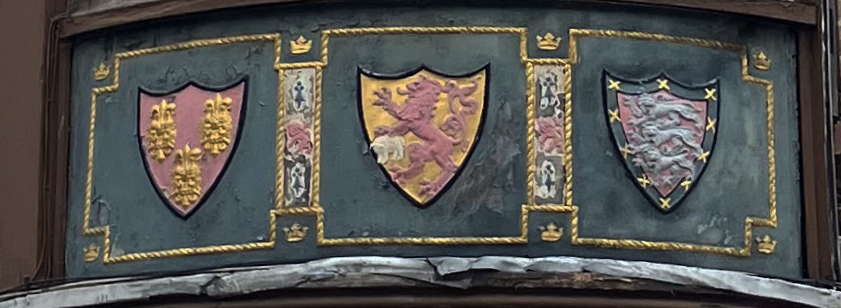
The Diocese of Hereford
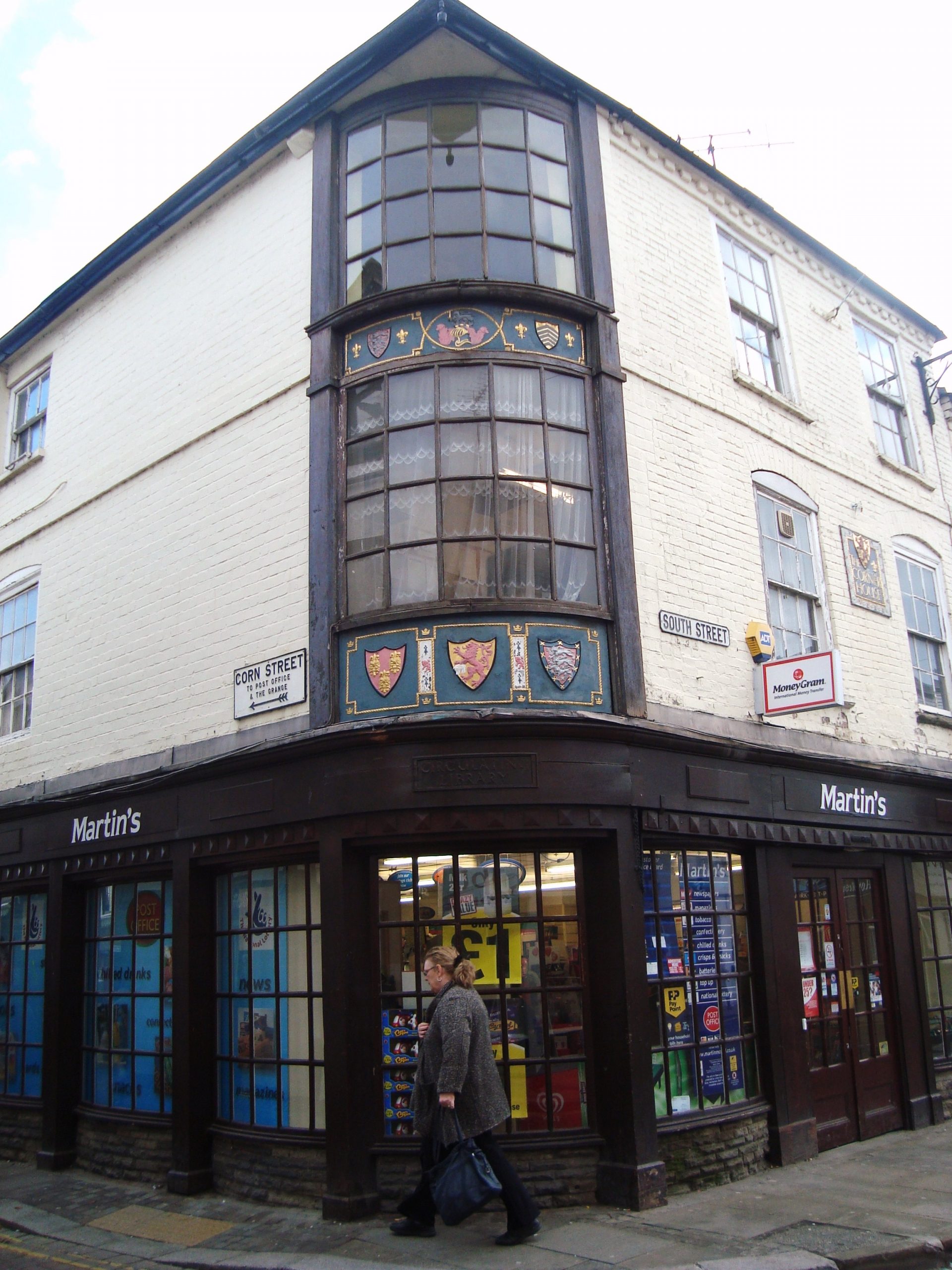
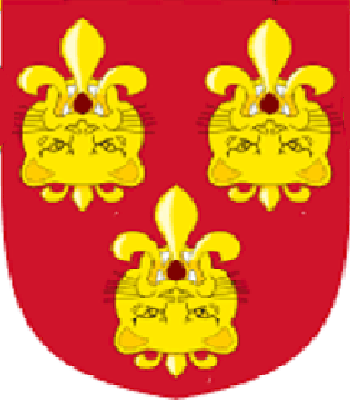
The arms of the bishop of Hereford
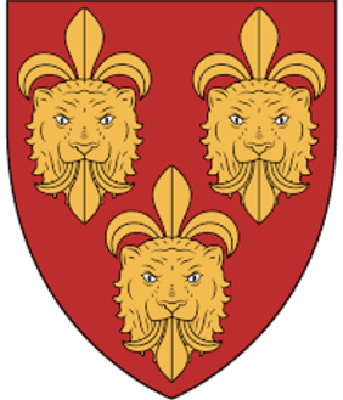
A variant of the Cantelupe arms with leopards upright
The shield on the left. above, is difficult to make out, but there can be no doubt that it is meant to be the arms of the Anglican diocese of Hereford. These arms contain the reversed heads of three leopards, each with a fleur-de-lys going in through the mouth and coming out at the back of the head. Heraldically these are called leopards’ heads jessant-de-lys, the word jessant meaning shooting up or coming forth. But these are not the original arms of the Hereford bishopric. They are based on the arms of Thomas Cantelupe who was bishop of Hereford from 1275 to 1282, and they were adopted by the diocese in the 14th century, following his canonization in 1320. In St Laurence’s church in Ludlow there are two 19th century windows, one showing the leopards’ heads upright and the other with them reversed. Maybe the right hand one, opposite, shows the arms of St Thomas himself, and the leopards’ heads were reversed to create the new diocesan arms. I’d welcome any comments on this point.
There are several versions of the Cantelupe arms and on his seal as bishop of Hereford there are just three fleurs-de-lys. He presumably added the leopards’ heads as a cadency difference and possibly these were reversed later to represent the diocese.
Thomas Cantelupe seems an odd person to have been made a saint. He was an ‘inveterate enemy of the Jews’ and is the person principally responsible for their expulsion from England by Edward I. This was apparently a significant point in his favour when deciding whether he should be made a saint! Although he was praised for pastoral work, he was combative rather than humble, engaging in a ‘great conflict’ with the argumentative ‘Red Earl’ Gilbert de Clare about hunting rights. More seriously, he angered the Archbishop of Canterbury so much that he excommunicated him! Thomas set off to Rome to plead his case but died some way before he got there. His successor at Hereford, Richard Swinfield, pushed for his canonization, but an excommunicated person could not be made a saint. It helped that various impressive miracles began to be attributed to him. In 1307 it was officially ‘proved’ by a council in London that he had actually been absolved by the Pope in Rome, but it took another 13 years until he was canonized, 38 years after his death.
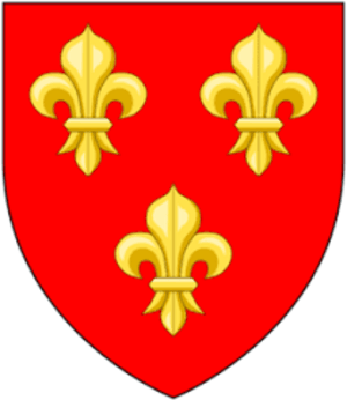
The early arms of Cantelupe that can be seen on St Thomas’s seal as bishop of Hereford on the right
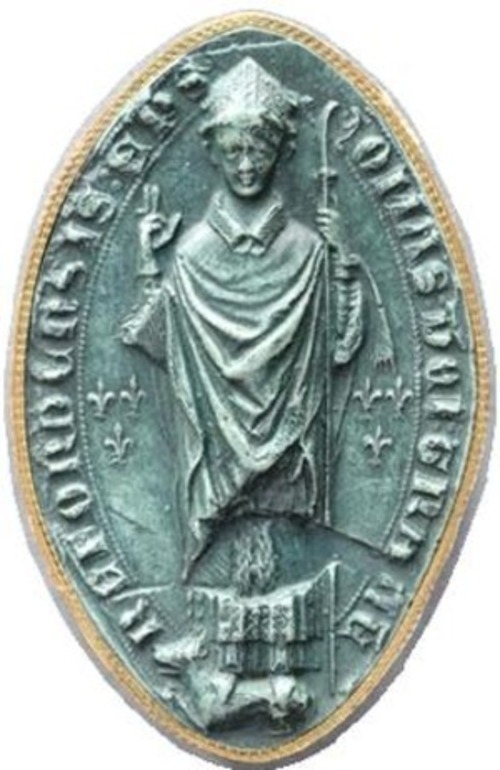
The City of Hereford
The coat of arms on the right of the group of three at Leominster is that of the City of Hereford. These arms are similarly of very great interest. The city was given its first charter by Richard I in 1189 and Hereford and the City of London are the only cities with the right to incorporate the three lions of England in their coats of arms. Until the 17th century the arms of Hereford were Gules three lions passant in pale argent.
In 1645 the Parliamentarians won a great victory over the Royalists at Naseby. After the battle, King Charles I travelled to South Wales to recruit more soldiers, staying at Hereford en route. The Parliamentarians then sent a Scottish Covenanter army to take Hereford. But this was not to be. Despite having a force of 14,000, the town was successfully defended for a whole month by a garrison of just 1,500 under Barnabas Scudamore. News of Montrose’s victories in Scotland caused the Covenanters to lift the siege and head north. On 16th September 1645 Charles I returned to Hereford. Full of praise for the defenders efforts in saving the city, he knighted Scudamore and granted an augmentation to Hereford’s coat of arms. Around the original arms he added a blue border with ten small silver saltires. The coat of arms of Scotland is Azure a saltire argent and the small saltires on the new shield are said to represent the ten Scottish regiments surrounding the city.
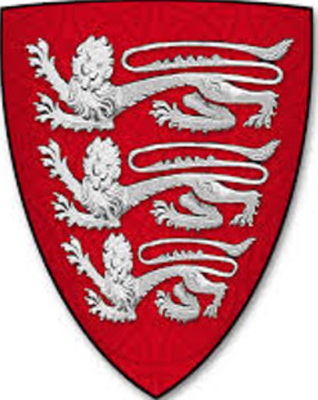
The early arms of Hereford
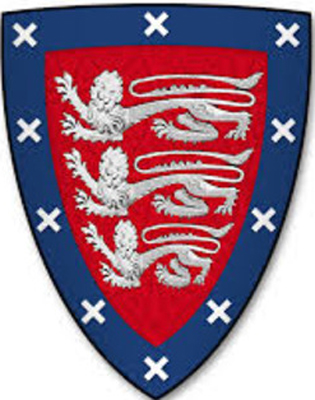
The present arms of Hereford
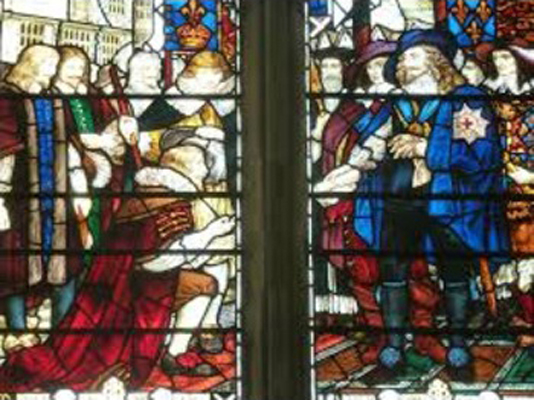
Charles I kmnighting Barnabas Scudamore in Hereford
The Town of Leominster
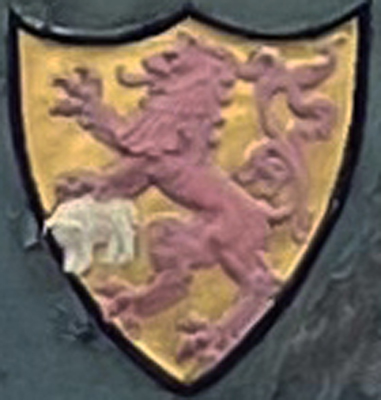

The shield in the centre of the three on the building in Leominster is the least known, but it is also of great interest. Historically, Leominster had no official coat of arms, but on the town’s silver mace, presented in 1723, there is a shield showing a lion rampant grasping a lamb or sheep in its left paw. It is thought that the ‘Leo’ part of the name ‘Leominster’ probably comes from the Welsh work for a nun, while ‘minster’ clearly means a church, referring therefore to the nunnery established there in the 9th century. But the creators of this unofficial coat of arms, probably in the 12th-13th century understandably decided to interpret the ‘Leo’ part of the name as a lion. It is believed that Leofric, earl of Mercia (d1057) was a benefactor of the nunnery or abbey. Being at the same time both valiant and devout the image of the lion and the lamb may have been meant to represent him.
Leominster Borough Council were eventually granted a coat of arms in 1955. Its blazon is Vert a lion rampant or grasping in its sinister paw a lamb argent. The crest is a Herefordshire bull and the supporter, on the dexter side is St Peter, one of the patron saints of the monastery since early times. The other supporter is a pilgrim and this refers to St. Ealfrid, who converted King Erewald of Mercia in the 7th century. The king then founded the first monastery in the area.
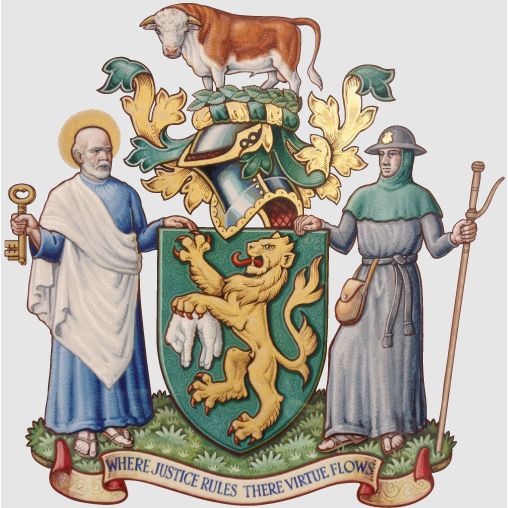
Thanks, Hugh, for a fascinating article. Is it possible that the lamb on the Leominster coat of arms is a reference to the Ryeland sheep from which Leominster derived much of its wealth – the Ryeland is one of the oldest English sheep breeds going back seven centuries when the monks of Leominster bred sheep and grazed them on the rye pastures, giving them their name?
Philip – it seems very possible that the reference is to the Ryeland sheep.
Re “Heraldry in Leominster” and the request therein for comments regarding the arms of the Diocese of Hereford, pertaining to the bearings of Saint Thomas Cantelupe that the escutcheon of the diocese is thought to be based upon. (The interesting article mentions that as Bishop of Hereford, Saint Thomas placed just three fleurs-de-lys on his seal and the piece also refers to there being several versions known of the Cantelupe armorials.)
Certain members of the Cantelupe dynasty under different spellings are found referenced in ‘Burkes General Armory’ cited from the time of King John onwards as bearing coats displaying various combinations of leopards’ heads, fleurs-de-lys and tinctures. Coupling with this, several websites and other sources such as relevant books offer that the armorials of the Hereford diocese are derived from Thomas Canterlupe’s own – just as the article reports. The “Heraldry of The World” website however adds that while the arms of the diocese were based on those of the powerful House of Cantelupe from which dynasty stemmed Bishop Thomas, Adam Orlton the next Bishop of Hereford but one after him, bore two similar fleurs-de-lys engraved in his seal and it was subsequent to his time when the arms became regarded as those of the See.
The “Heraldry of The World” website continues by adding that, “The leopards’ heads are usually drawn reversed, but there is good reason for believing that they are nothing more than a decorative elaboration of the ball or knop from which the leaves of the flowers spring. The earliest examples of the arms of Cantelupe show three golden fleurs-de-lis on red…… But usage has decided that the knops shall be leopards’ heads reversed.”
Regarding the more sheepish aspects of “Heraldry in Leominster” and the ‘Ryeland’ breed.”
(For those who live far away and so might not know, Leominster is usually pronounced as, “Lemster.”)
It seems that the lamb grasped by the lion within the arms of “Leominster Town Council” – not “Leominster Borough Council” which is defunct – is always referred to as simply a “lamb;” with no reference made to its breed. Information on the “Civic Arms of England, Wales and Northern Ireland” website is that these bearings were originally granted in 1955 to Leominster Borough Council but transferred in 1976 following local government reorganisations. The website bears out that the lamb is said to cant on the pious side of Lady Godiva’s husband’s nature, (Earl Leofric) as well as it referencing the importance of the town as a wool production centre.
However the “Civic Arms of England, Wales and Northern Ireland” website also gives that the armorials of the Leominster District Council, which was an amalgamation of seven local authorities were officially granted by the College of Arms in 1978 and were: “Barry wavy vert and argent on a chevron gules between in chief two Hereford Bulls’ heads and in base a Ryeland Sheep’s head all caboshed a pear between two hop cones tops downwards all between two apples Or.” Which is something of a mouthful to visualise but the website adds that the face of a Ryeland sheep is taken from the device of Leominster and Wigmore Rural District Council, one of the amalgamated authorities and is in reference to the wool industry so important to the area.
(The “Heraldry of The World” website gives that these arms were used until the council’s dissolution in 1998, when Leominster District Council was absorbed into the unitary Herefordshire Council. Plus gleaned from other sources: Ryeland sheep brought such wealth to Leominster that their fleeces were dubbed “Lemster Ore” (Leominster Gold).